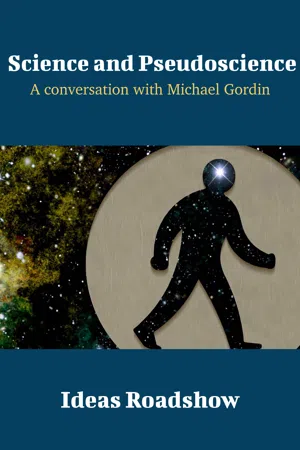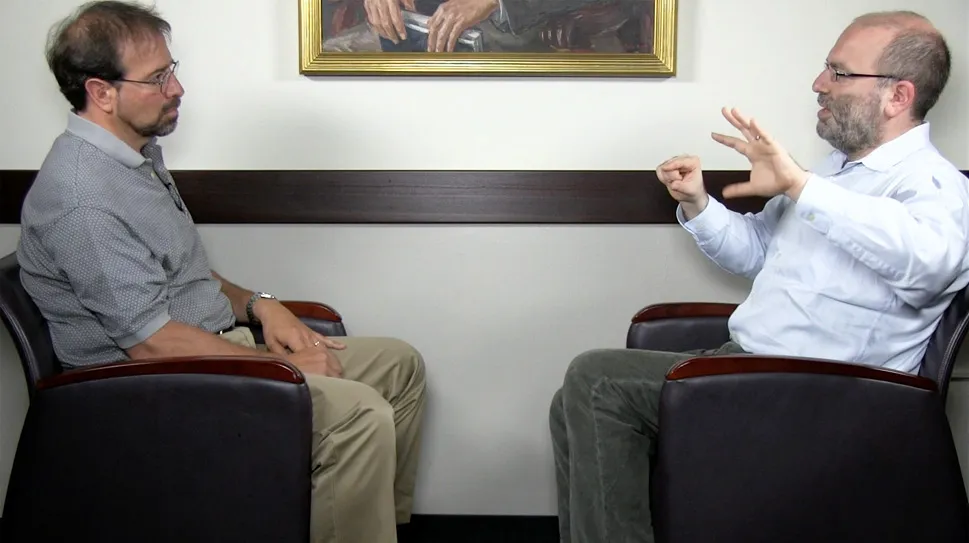![]()
The Conversation
![]()
I. A Counterculture Hero
Introducing Immanuel Velikovsky
HB: I’m looking forward to talking to you about the distinction between science and pseudoscience and how best to categorize it—indeed, whether it makes any sense at all. But let’s start off with the figure of Immanuel Velikovsky. You chose him as an exemplar of the boundary between science and pseudoscience, but you cheerfully admit that most people today wouldn’t have any clear idea of who he actually was. So let’s just start there. Who was this guy?
MG: One of the reasons why I chose him is precisely because he was once a household name and now is absolutely not: the fact that the story therefore has a distinct end is particularly attractive to me.
But let me start with who he was. He was born in 1895 in the town of Vitebsk, which is now in Belarus, but was then part of the Russian Empire—it’s the same town Marc Chagall was from, incidentally.
He comes from a Jewish family and when he’s 5 years old, the family moved to Moscow. He eventually gets a medical degree and then the Revolution hits. His family gets out, emigrates to Berlin for a few years and then settles in Palestine. His father buys some apartments in Tel Aviv and Immanuel—the youngest of the three children and the only one who leaves for Tel Aviv with the parents—manages those estates.
He married a violin student while he was in Berlin who moves down to Tel Aviv and they have two daughters. At this point, he’s just an ordinary, uninteresting guy.
Slightly more interesting is that after his mother dies he decided that, even though he’s trained as a medical doctor (although he doesn’t practice), he would like to retrain as a psychoanalyst. So he goes to Vienna for a few years around 1934 and studies psychoanalysis before coming back to Tel Aviv.
At this point he’s still pretty uninteresting, historically speaking. But in 1938, he walks by a bookstore and sees a book by Freud. Being a psychoanalyst, he’s naturally interested in what Freud had to say. The book is called (in English translation), Moses and Monotheism. Velikovsky reads it (in the original German) and he’s incensed.
The argument of this book is that Moses is not a Hebrew at all: he’s an Egyptian who was a renegade priest within the monotheistic sun god cult of the Pharaoh Akhnaton—a cult which was suppressed very strongly after Akhnaton’s death. Moses takes this religion and sells it to the slave population, the Hebrews, who eventually export it from Egypt with Moses. The sun god that they started with gets somehow fused with a Midianite volcano deity associated with Mount Sinai called Jehovah, and that’s how modern Judaism emerges.
That’s bad enough for Velikovsky, who is raised in a very observant Jewish household and is strongly connected to various religious strands of Zionism, together with secular aspects.
But then it gets even worse.
Because Freud then claims that you can do the same thing you do with dreams to the Bible. That is, what’s going on in the Bible is a lot of metaphors and illusions that are like the dreamwork, the images we get in dreams. And if you know how to read them right, you can decode the underlying story that this dreamwork is trying to suppress. Freud claims that this underlying story is actually the murder of Moses by the Hebrews who are sick of his puritanical regulations.
This is horrifying to Velikovsky, and he decides he’s going to write a refutation of it. He’s a psychoanalyst, after all, he says to himself: he can do this. He takes a sabbatical with his family, and they all leave on a steamer to go to New York where he can work in a better library. He arrives in August 1939, settles down in the Upper West Side and goes off to work at the New York Public Library on 42nd Street.
While he’s there, he does a great deal of research, and comes to believe that he finds a text, a translation of an Egyptian text that he thinks is the same thing as Exodus, just from the Egyptian side. And he says to himself, “Wow, maybe these events actually happened, but they are not miraculous. What if they were natural disasters? Maybe I can read all of these myths and see if there are homologies between them?”
Not just analogies, it should be stressed, but actual homologies —that is, stuff that has a common cause. So he reads Chinese myths, Mayan myths, South Asian myths, but mostly Middle Eastern myths, and consistently finds these same things: earthquakes, rocks from heaven, fire from the sky, lightning, massive flooding, and so forth.
So then he concludes, “There was a natural disaster. I can intuit it from global myth, and then I can reverse-engineer things to discover what the global catastrophe actually was”—using, ironically, the same technique that Freud did with Moses and Monotheism.
So he figures it out. In 1950, he publishes it in a book called Worlds in Collision, issued by Macmillan Publishers, the leading scientific press in the US at that time; and it rockets to the top of the bestseller lists. It really makes quite a splash. Everybody’s discussing it. It’s the book of the year. And then about eight weeks into its publication run, Macmillan mysteriously decide that they’re going to give it away, they’re going to get rid of the book with no cost—just give it to Doubleday, a competitor of theirs.
So then the backstory starts to come out: scientists had written to Macmillan—a few scientists, not that many, about 8-12, saying, “We are deeply offended that you, a scientific press, published this book.” They describe it as “claptrap”, “fictional science”, “science fiction”, “baloney” and so forth.
HB: Did they use the word “pseudoscience” at that time?
MG: The term “pseudoscience” gets used at various points, but usually not in these first letters—it gets used quite a bit in the reviews of the book that come out later. And once the book appears in April 1950, all the reviews from scientists are extremely negative.
The private letters to Macmillan essentially say, “We no longer think that you’re a reliable press, so we’re thinking about boycotting you.” What that means is not buying their books, not assigning their books to undergraduates (which represents 70 percent of Macmillan’s sales), not submitting works for them and not refereeing for Macmillan-related journals.
One of the most articulate of these letters comes in response to an editor who says, “I want the referee report that you owe me.” And the scientist responds, “I’m not going to give it to you. I’m not going to give it to you because you guys published this book.”
Finally, George Brett, who’s the head of Macmillan, says, “We better not do this.” So he “de-acquisitions” the book—that’s the term I like to use for it. When that becomes public, it becomes this publishing scandal, and many people who enjoyed the book start saying, “Well, we don’t know whether the book is right. Velikovsky thinks it is. But this is like Galileo saying the truth about the heavens and the orthodoxy doesn’t want to hear it, and he has been repressed by this homogeneous establishment that doesn’t like the fact that he’s an outsider giving a new perspective on how things are going on.”
That makes the book even more popular; and for a couple of months, it’s still at the top of the bestseller lists. And then it sort of vanishes for a bit. It’s dormant f...

